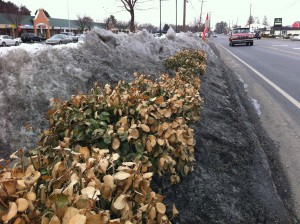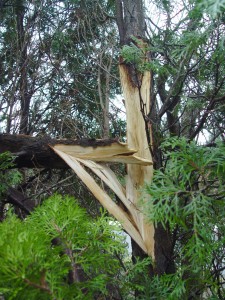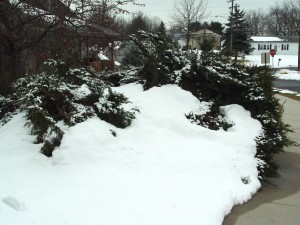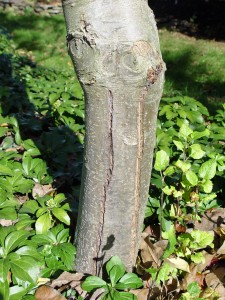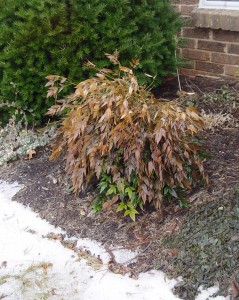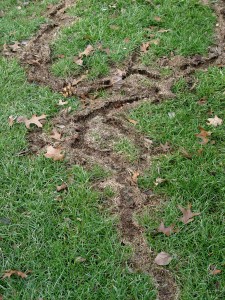Healing Your Winter-Damaged Yard
March 12th, 2014
Some of our winters are mild. Others snow us under, ice us up, freeze us out and “polar-vortex” us beyond patience.
Let’s roll through some winter-damage issues and look at what you should do about them (or not):
* Broken branches. Many a white pine branch ends up on the ground as a result of snow and ice loads. Ditto for other weak-wooded tree and evergreen species (birch, poplar, ornamental pear, Siberian elm, arborvitae, etc.)
“When we start getting an inch of ice on branches, that’s when I see things like oaks with good attachments losing branches,” said Vincent Cotrone, a Penn State Extension urban forester for northeastern Pennsylvania.
Check your yard where branches came off, and make clean cuts back to the outside edge of the ring where the lost branch attached to the trunk or larger branch.
Stubs can get infected and carry disease back into the tree.
* Hangers. Snapped, cracked and popped branches that are still hanging on need to come off.
Be especially wary of bigger ones that might drop at any time and cause damage to you, others and property underneath.
Call an experienced (and insured) tree professional to remove these dangers, which arborists refer to as “widow-makers.”
Also be aware that hangers are often under tension and will snap up and seriously injure unaware homeowners wielding chainsaws.
Cleaning off small branches from the ground is fine. For the bigger and higher stuff, I’d recommend biting the bullet and calling a pro.
* Saggers. Lots of arborvitae, Leyland cypresses, yews, boxwoods and similar evergreens might look badly misshapen, though not quite broken apart.
As temperatures warm, these might spring back into shape better than you think. So wait until the weather warms consistently before doing anything drastic.
In some cases, you might be able to use ties to bundle up and pull back splayed-apart branches.
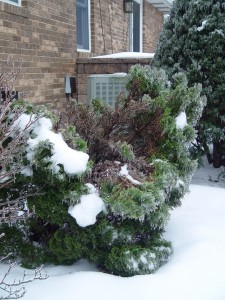
Some mildly to moderately splayed-apart shrubs will bounce back. Others may call for bundling or removal.
“You can do that, but if you forget to untie them later, the part above where you tied could die back from the wood being constricted,” says Mechanicsburg arborist Bob Carey, host of the Garden Talk radio show on WIOO-1000AM.
He suggests leaning toward soft, wide bands as tying material instead of narrower rope or wires.
He also advises not tying too tightly and checking later in the season to see if the form has recovered when the ties are loosened.
Pruning and patience might also solve a broken and saggy situation.
“Prune out all of the damaged stuff, then sit back and wait,” says Eric Vorodi, an arborist and owner of the Boiling Springs-based About Trees Consulting. “Wait to see what happens, and more importantly, wait to see how much it bothers you to look at the plant. Most people assume that the plant will be so deformed that they won’t be able to tolerate it. But maybe it won’t be so bad once it grows in.”
* Physical insults. “I can’t tell you how many commercial properties I’ve seen where snow is pushed back into fir trees planted 5 feet from the road,” says Carey.
Back-to-back-to-back dumpings can result in blown, shoveled and plowed snow piled on top of shrubs along walks and roads.
Knocked-over, decapitated and up-rooted plants are goners.
Trunks with gouges may heal better than you think. Just cut off any hanging bark and let the wounds air-dry. No need to treat wounds with tar, paint or other gunk.
For broken branches and flattened shapes, deal with those as mentioned above. Don’t be too quick to remove stuff that looks bad before warm weather has had a chance to help heal.
* Cold injury. Yeah, we might see some diebacks and possibly even dead plants in cold winters in species that are borderline hardy to central Pennsylvania.
If you’ve pushed the envelope with photinia, camellia, palms, figs, loropetalum and such, colder-than-usual winters are when you might pay. Two points to keep in mind:
1.) It may not have been as cold as you think… at least not to the point of killing plants that have evolved to tolerate zero-degree lows.
“Zero is really not that unusual for us,” says Carey. “Our plants have the mechanics to endure that.”
2.) Winters that get cold and stay cold are better than ones that yo-yo back and forth between warm and cold.
Woody plants in the correct winter-hardiness zone (Zones 5B-7A in our case) deal with cold by “hardening” themselves over winter.
“They make their own sort of antifreeze within the cells to prevent intercellular ice formation and cells rupturing,” says Cotrone.
Having consistent cold is actually less harmful than one of those yo-yo winters… or worse yet, when a late cold snap hits after temperatures warmed.
Again, don’t be too quick to remove cold-injured plants. Some of these plants suffer dieback of the top growth but push up new growth later in spring from the roots.
Wait until at least the end of May to see what happens. You’ll likely be able to just prune off dead wood and let new growth fill back in.
* Frost cracks. Another way winter damages trees is by freezing wood overnight and then splitting it apart vertically in the morning when sun quickly thaws it.
This expansion-related frost-crack damage happens particularly to thin-barked species such as cherry and maple, and it often happens on the eastern (i.e. morning-sun) exposure.
The good news is that “most trees grow out of this,” says Cotrone. “If the tree is otherwise healthy, it’ll put out callus (tissue) and heal the wound.”
No need to paint or tar these splits.
* Winterburn. Evergreens – especially broad-leaf ones, such as holly, cherry laurel, nandina and boxwood – might look browned and beaten toward the end of a cold winter.
Most of that leaf injury is due to cold winter winds.
What happens is that wind continues to sap moisture from the leaves over the winter, but the frozen ground doesn’t allow the roots to replace that loss. The result is browning around the leaf tips and margins.
An end-of-winter pruning or shearing back to live wood will fix almost all of this. Given a month or two of new growth, most of these winterburned evergreens will be as good as new.
* Salt damage. This one’s more insidious. The sodium in all of that road salt and bags of rock salt can interfere with the ability of plant roots to take up moisture.
Excess salt in the soil also can make the soil more compacted, which interferes with root growth.
Both of those show up in summer leaf-browning symptoms that usually get blamed on heat and drought.
Soaking spring rains are the best antidote for sodium overload – both for salt spray on foliage and salty melt-water in lawns and beds.
If we don’t get that, consider several good soakings with a hose, especially to beds along roads, walks, driveways and other areas where salt-laden snow got dumped or where salty spray or runoff might have ended up. For more on this, read a post I wrote on salt injury to plants.
* Flower or leaf-bud injury. On some plants, the roots and branches might weather the cold fine, but the more tender leaf and flowers buds might not.
The result is that your hydrangeas or forsythias might not bloom that season.
That’s not a long-term problem – so long as the roots and branches are fine. New buds will form the season following the injury, and the plant will go back to normal leafing and blooming the following year.
There’s nothing you can do about it anyway.
The curious thing to watch for is how snow can actually be a plant-protector as well as a plant-flattener.
Buds low on the plant where snow surrounded them might have been insulated enough from the cold to survive, while buds sticking up in the bare, cold air might’ve croaked. Thus you’ll see a plant blooming at the bottom but not at the top.
The most serious bud threats come in years with very cold and windy conditions without any insulating snow. Or in years with those late cold snaps after it’s warmed for awhile.
* Animal damage. Last but far from least, how’s your lawn looking? See any surface tunnels that zig-zag all over?
That would be damage from voles, which are mouse-like rodents that normally hide under groundcover and along walls so predatory birds don’t eat them.
However, under snow cover in winter, voles venture out into the open yard in search of food. The tunneling is collateral damage that will usually fill back by late spring.
Scatter some new grass seed at the end of March if you want to speed up the process.
Much worse than lawn injury is what voles, rabbits and other rodents do to trees, shrubs and groundcovers over winter.
These sharp-tooth little varmints can eat the roots out from underneath a tree or girdle all the bark off. That can kill whole large trees.
Once that damage is done, it’s done. The solution is to wrap tree trunks heading into winter or taking steps to eliminate or repel the rodents (not easy).








